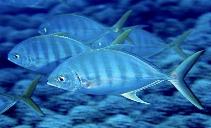| Family: |
Carangidae (Jacks and pompanos), subfamily: Caranginae |
| Max. size: |
70 cm TL (male/unsexed); max.weight: 8,000.0 g |
| Environment: |
reef-associated; brackish; marine; depth range 0 - 60 m |
| Distribution: |
Indo-Pacific: Red Sea and East Africa (to Port Elizabeth, South Africa, Ref. 3197) to the Hawaiian Islands. |
| Diagnosis: |
Dorsal spines (total): 9-9; Dorsal soft rays (total): 26-34; Anal spines: 3-3; Anal soft rays: 21-26. Description: Blue green above, paler below; 5-6 dusky bands on sides; sometimes with inconspicuous golden spots (Ref. 3197). Bluish green dorsally, shading to silvery on sides, with 7-10 grey bars; dorsal and anal fins sometimes yellowish. Body oblong and compressed, dorsal profile more convex than ventral profile; snout bluntly rounded. Breast scaleless ventrally to origin of pelvic fins. LL with 21-37 small scutes. Both jaws with narrow bands of villiform teeth, becoming obsolete with age. (Ref. 90102) |
| Biology: |
Adults are found in coastal waters adjacent to sandy beaches; also found to depths of 60 m, often near reefs (Ref. 30573). Pelagic (Ref. 58302). Singly or in small groups (Ref. 48635). They feed mainly on mollusks, benthic crustaceans, and occasionally on small fish (Ref. 90102) that are abundant in the lagoons. Excellent food fish (Ref. 12484), the flesh is rarely poisonous. Minimum depth reported taken from Ref. 128797. |
| IUCN Red List Status: |
Least Concern (LC); Date assessed: 09 March 2015 Ref. (130435)
|
| Threat to humans: |
reports of ciguatera poisoning |
Source and more info: www.fishbase.org. For personal, classroom, and other internal use only. Not for publication.

